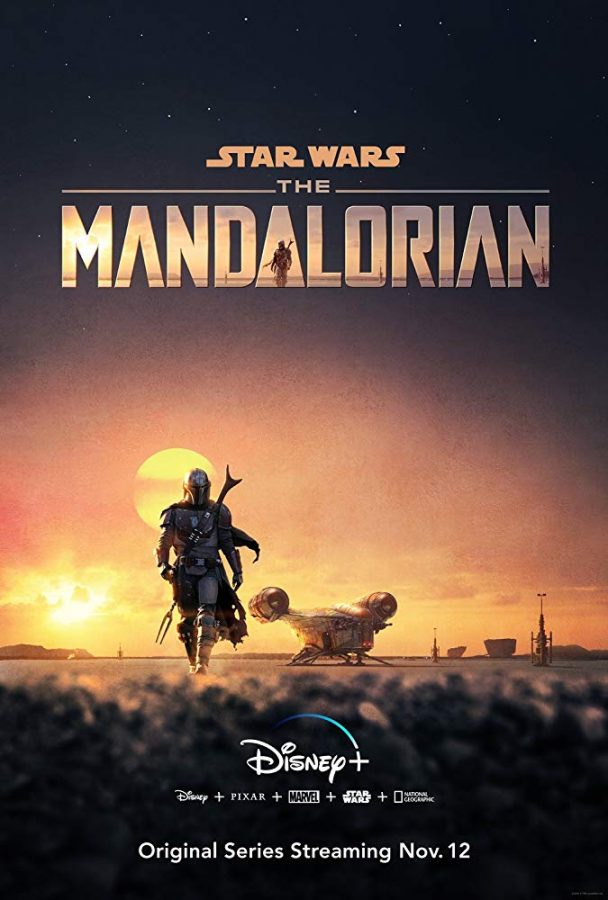Warning: Spoilers revealed below
“The Mandalorian”, the TV show launching the streaming platform Disney +, returns to the origins of Star Wars in a way that both avid fans and casual consumers will enjoy.
The series is set in the Star Wars universe after the Empire has been destroyed by Luke and the rebels (Movies 4-6), but before the rise of the First Order (7-9). The show features the Mandalorian, the main character, played by Pedro Pascal as he flies around the galaxy searching for fugitives as a bounty hunter.
He gets hired to capture or kill a 50 year old, but it turns out his mark is a baby as species age differently in Star Wars. The audience named the child, ‘Baby Yoda’ as he is the same species as Yoda, a character found in previous Star Wars movies.
It is important to realize he is not a young yoda. According to the show’s creator Jon Favreau, “It’s the easiest, shortest, most hashtagable way to identify that character, which is identified in the episode as ‘The Child.’” It is also important to note while ‘Baby Yoda’ is a cultural phenomena, he does not really do anything other than look cute and help the plot move once or twice.
The Mandalorian eventually captures and turns in ‘Baby Yoda’ to a former empire officer. Yet, the Mandalorian decides to break the code of bounty hunters and rescue ‘Baby Yoda’ before he could be turned into a science experiment. The show progresses into the story of how the Mandalorian and ‘Baby Yoda’ escape capture by traveling all of the galaxy to beautiful and unique planets where they almost always encounter trouble.
The production of the series rivals the likes of “Game of Thrones” with the immersive sets and special effects because of the series’ 100 million dollar budget and the talent of Jon Favreau
Favreau might have created a season with abnormally short episodes ranging from 25 to 45 minutes long. However, he made up for it by giving the audience a show that was similar in quality to the large blockbuster movies in the Star Wars Franchise.
The season as a whole gave off similar vibes not seen since the original trilogy of Star Wars movies. It had a sense of grittiness and rawness that should come with a society full of impoverished people and outlaws.
Instead of sets that were clean and pristine, they reflected the wear and tear the people were experiencing from the fallout of the destruction of the Empire. This immersiveness allowed Favreau to tell a story about a place with not only the plot, but with visuals as well. Building onto the visuals, the way Favreau and the directors world-built each planet and culture was unreal.
Many modern day franchise movies, including the “Rise of Skywalker”, are plot driven and usually focused on only the main characters. However, “The Mandalorian” somehow found time to explain the inner workings of the different cultures visited on the vast number of planets and places throughout the series.
One of the great examples came when the Mandalorians say,“This is the way” which is the code to live their life by.
The audience did not need to be told through dialogue what this meant, but instead could see and feel the code throughout the season in the actions and decisions of all the Mandalorians. This policy of showing and not telling is a breath of fresh air that the franchise sorely needed.
The series kept adding entirely new dynamics to Star Wars Universe, and none were as shocking the stormtrooper scene in the last episode. Usually stormtroopers are heartless, inaccurate soldiers that are symbols of evil; they often are not thought of as humans.
Instead, in this scene, they were portrayed as real humans as they bantered amongst themselves for about two minutes like any other brother-in-arms on the rebels side would do. By adding in these little scenes encompassing both sides of the fight, the show was much more captivating and impactful to the audience.
Even with all of its perfections, the series still experiences flaws that weighed it down. However, these flaws often came to mind after the episodes finished which softened their blows.
The one problem the show faced was the inconsistency in the advancement of the plot. In episode 6, the Mandalorian gets caught up with some old friends and runs a prison break. Yet, the plot does not move forward after this long episode. The audience could skip episode 6 and never be the wiser as it adds nothing to the main story.
The episode really did not add any character development either, which plagued every episode in the series. One of the main characters to the audience is ‘Baby Yoda’. However, nothing is really learned about him at all after hours of watching the show. In a few places, it seems like he is just there to look cute and capture the audience’s love so they continue to watch the series and buy merchandise.
Even with the few flaws of the script, “The Mandalorian” is a beautifully constructed series with impressive worldbuilding and rawness that is often skipped over in today’s film business. It gives the audience everything great from the original trilogy that is missing in the newest trilogy and more with the cultural phenomena known as ‘Baby Yoda’.









